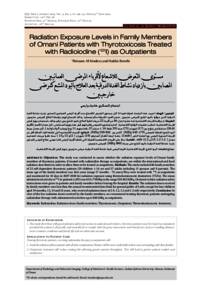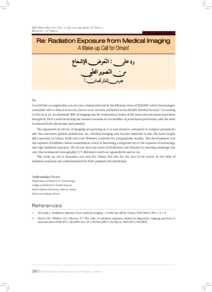Document
Radiation exposure levels in family members of Omani patients with thyrotoxicosis treated with radioiodine (131I) as outpatients.
Contributors
Bererhi, Haddia., Author
Other titles
مستوى التعرض للاشعاع لأقرباء المرضى العمانيين المصابين بازدياد نشاط الغدة الدرقية بعد العلاج باليود المشع كمرضى خارجيين
Publisher
College of Medicine, Sultan Qaboos University.
Gregorian
2009-08
Language
English
English abstract
Objectives: This study was conducted to assess whether the radiation exposure levels of Omani family members of thyrotoxic patients, if treated with radioiodine therapy as outpatients, are within the international and local radiation dose limits in order to allow them to be treated as outpatients. Methods: The study included 86 family members of 22 self-dependent thyrotoxic patients (29 children ≤ 16 yrs and 57 adults including 11 spouses and 8 parents). The mean age of the family members was 26.6 years (range 17 months - 75 years).They were treated with 131I as outpatients and monitored for 10 days in 2007-2008 for radiation exposure using thermoluminescent dosimeters (TLDs). The mean administered activity of 131I to patients (±SD) was 610 ±79MBq in the range 520-862 MBq. Oral and written radiation safety instructions were given to patients and family members before leaving the hospital. Results: The radiation doses received by family members were less than the annual recommended dose limit for general public of 1mSv, except for four children aged 19 months, 12, 13 and 15 years, who received radiation doses of 2.9, 1.2, 1.2 and 1.2 mSv respectively. Conclusion: In view of the low radiation doses received by the family members, we recommend treating thyrotoxic patients undergoing radioiodine therapy with administered activities up to 800 MBq as outpatients.
Member of
Resource URL
Citation
Al-Maskeriyah, Ibtisaam, & Bererhi, Haddia (2009). Radiation Exposure Levels in Family Members of Omani Patients with Thyrotoxicosis Treated with Radioiodine (131I) as Outpatients. Sultan Qaboos University Medical Journal, 9 (2), 148–152.
Arabic abstract
الهدف: اجريت هذه الدراسة لمعرفة فيما اذا كان مستوى التعرض للاشعاع عند أقرباء المرضى العمانيين المصابين بازرياد نشاط الغدة الدرقية الذين عولجوا باليود المشع كمرضى خارجيين, ضمن الحدود المقبولة عالميا ومحليا. وذلك للسماح لهم لهم بمواصلة العلاج كمرضى خارجيين. الطريقة: تم مراقبة الجرعات الاشعاعية لمدة عشرة أيام ل 86 من أقرباء 22 مريضا تلقوا العلاج باليود المشع بدون ترقيد وذلك باستخدام جهاز قياس الجرعة الاشعاعية. اعطيت تعليمات الوقاية الاشعاعية كتابيا وشفهيا للمرضى واقربائهم قبل مغادرتهم المستشفى. كان معدل الأعمار للأقرباء (26.6) سنة والمدى يتراوح بين (17) شهرا و (75) سنة (29 طفلا 16≤ سنة و 57 بالغا منهم 11زوج/زوجة و8 والد/والدة). كان معدل جرعة اليود المشع المعطاه للمرضى (520-862 MBq). النتائج: الجرعات الاشعاعية التي تلقاها أفراد العائلة أقل من الجرعة السنوية الموصى بها لعامة الناس (1mSv). ما عدا أربعة أطفال أعمارهم (19) شهرا و (12و 13 و 15) سنة تلقوا جرعات اشعاعية بمعدل (1.2 1.2, 2.9 و 1.2) mSv. الخلاصة: بناء على الجرعات الاشعاعية القليلة التي تلقاها أقرباء المرضى فاننا نوصي بعلاج المرضى المصابين بازدياد نشاط الغدة الدرقية باليود المشع حتى جرعة (800 MBq) كمرضى خارجيين.
Category
Journal articles


